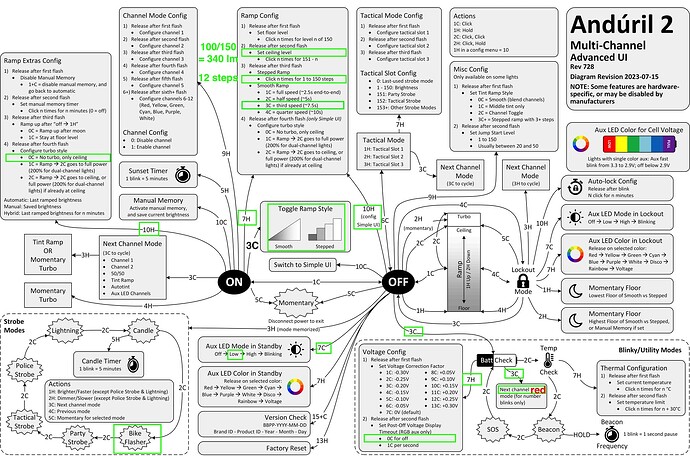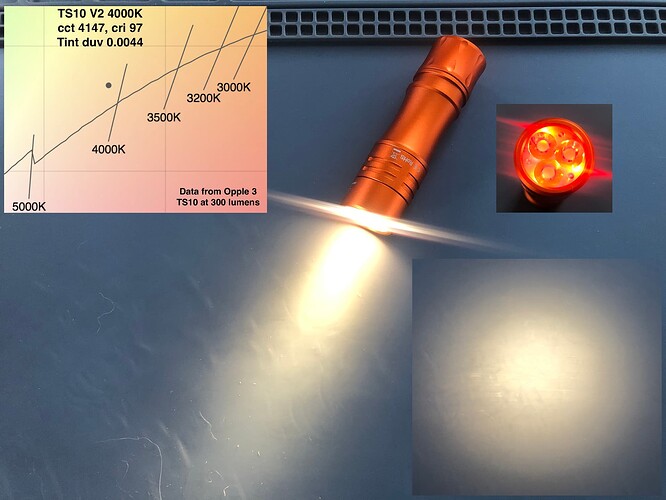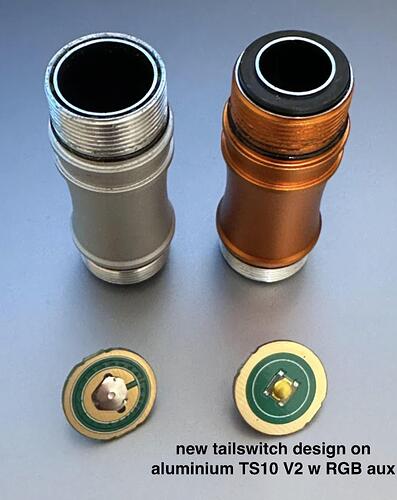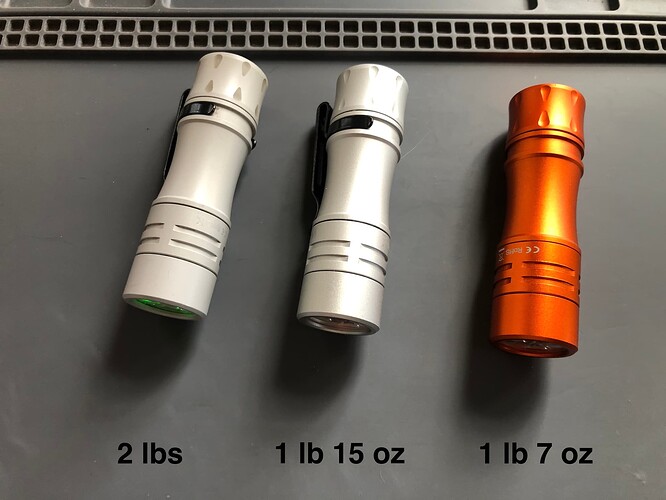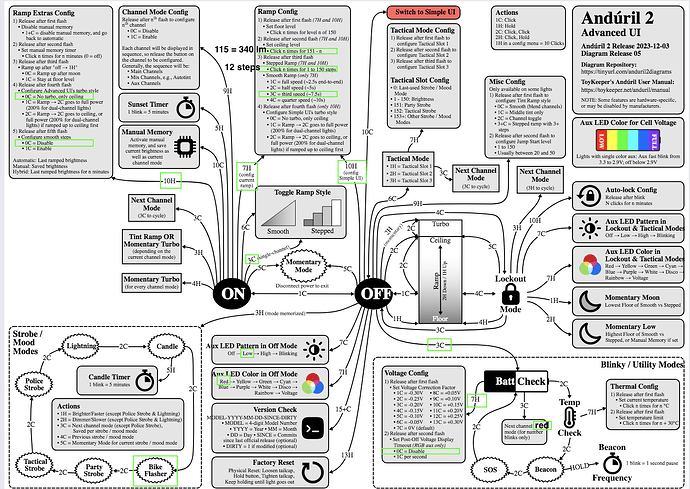I received this light free of charge as a review sample. The review is written as an Intro to Anduril, for new users. Im heavily biased. Anduril is my favorite UI, and the TS10 is one of my favorite little lights.
my first steps in setting up the light:
-
I remove the head and remove the orange disc that blocks battery contact during shipping. Then screw the light back together, with the battery inside. The light blinks once to confirm battery contact. I then remove the plastic film that protects the lens.
-
I do 3C from off for battery check, and count the blinks. There were 3 followed by 9 more, that tells me the battery is at 3.9V. I did not recharge, I usually wait to get below 3.6V before recharging.
After it blinked out the voltage one time, the blinks stopped by themselves. This tells me the light arrived in Simple UI, by default.
RGB Aux come w a new Anduril feature that displays the battery voltage as an Aux color for 4 seconds after turning off the light. The Aux then switch to a default of Red at High Brightness.
I like Red aux, but want them to be dim, so I made my first Recommended settings change:
- I did 7C from off, three separate times, so the Red Aux are now on Low Brightness,
I set the Aux to Low brightness, to preserve battery life. Be aware that if you choose to use High brightness Aux 24/7 (not recommended), the battery can be drained in less than a week.
- A note of Caution!
I noticed the bezel gap seemed a bit larger than expected.
When I tried to unscrew it, I found I could loosen it easily by hand.
So I made a point of tightening the bezel down firmly.
I took the head off the body and used rubber strap wrenches, if you dont have that tool, I suggest just making it as tight as you can with bare hands, or with rubber gloves on.
That completes the initial setup. The light is now ready to use.
I proceeded to check the min and max outputs in Simple Mode, which arrives in Smooth Ramping by default. My homebrew lumen meter (which reads low on max output), said 0.6 lumens low, and 700 lumens high.
I then switched to Advanced UI by doing 10H from off.
I confirm the light is in Advanced by doing battery check (3C from off), which now repeats in a loop until I clic off.
Low mode in Advanced Smooth Ramping is about 0.01 lumens and maximum is about 920 lumens, which begins to drop quickly.
Next I changed several Advanced mode settings to my Personal preferences. I use this flowchart to keep track of the changes:
-
I disable Turbo.
-
I change the Advanced ceilings to level 100/150, which gives about 340 lumens. Because I like to limit my Anduril lights to an output that is close to Sustainable…
-
I also lower the Simple mode ceiling to 100/150, = about 340 lumens.
note, for Simple mode, setting the ceiling affects both Smooth and Stepped ramping, unlike Advanced mode, which allows separate ceilings, (and floors) for the two ramping styles.
-
From On in Advanced, I change from Smooth Ramping to Stepped Ramping by doing 3C.
-
I change the number of Stepped modes in Advanced, to 12 steps (personal preference). The default is 7 steps in Advanced and 5 steps in Simple mode.
-
I change the Advanced ceiling in Stepped ramping to match the ceiling I use in Smooth ramping.
-
I change the default blinky, which is a flickering “Candle Mode”, to the Bike Flasher option, as I find that useful to alert cars when Im a pedestrian in a crosswalk.
-
I change smooth ramping speed to be slower, I like option 3, shown on the above flowchart.
-
I turn off Post Off Voltage display, see the flowchart box titled Voltage Config if you want to do that.
If you want to learn more about the many Optional features available in Anduril, I suggest you read a Manual. Here is an Online version: Anduril 2 Manual · Ivan: Thinking
Note Anduril is ever evolving, there are a lot of different versions. Not all manuals list the same features, and not all Anduril lights use the same firmware version. There may be things listed, or missing, in a manual that do not match a given light. Same is true for flowcharts.
If you are new to Anduril and have questions I will be happy to help…
Cautions and Safety Warnings:
- Anduril has no automatic Thermal Step down when using blinkies.
Do not use too high an output with blinkies, when you are not holding the light, or you may burn yourself when you touch it.
-
Do not use Physical Lockout with.a TS10, because if the tailswitch gets pressed it starts a Factory Reset and erases any optional settings you have changed.
-
Do not use Turbo over and over again, as this can cause excess heat that can burn you.
-
Do not use batteries that are 52mm or longer. H10 button top, and some Protected cells are too long and will not allow the light to close all the way, and then the tailswitch wont work properly.
I verified Voltage and Thermal calibration w a DMM and IR Thermometer and confirmed both arrive accurate. No need to change calibration of the Voltmeter and Thermal sensor in the light.
I recommend buying the light with the stock battery.
If you want to buy other batteries, I recommend the extra high capacity Vapcell F12 (both flat top and button top work in the TS10). I also recommend the USB rechargeable 14500 cells from Lumintop, Acebeam, or Skilhunt.
One of the things I especially appreciate about the TS10 are the Ultra Low Firefly outputs… this is a light that is really well suited for nightstand use. The Aux make it easy to find in the dark, and the low modes are low enough not to ruin our sleep hormones when lighting a path to the bathroom in the middle of the night.
The one physical thing I change on all my TS10’s is the pocket clip. My personal favorite is the clip from a Lumintop EDC05. I like that it is very short, so it does not ride on the head when unscrewing to change the battery.
otoh, When you order a TS10, I highly recommend also ordering the alternative long black TS10 clip that Wurkkos sells (similar to an Olight Baton clip)… The long clips work really well on a Hat, and the TS10 has a nice floody beam for close range handsfree tasks…
imo the TS10 is a great little close range Urban EDC light,
Recommended.

